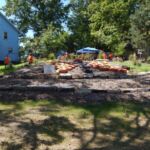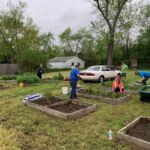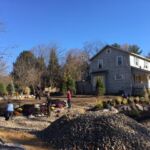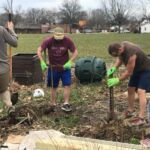HCP-MV Partner Spotlight: Mahoning & Trumbull County Land Banks
A Decade of Demolitions to Grow a Greener Mahoning Valley
A lot has changed over the last 10 years. Common sights in 2011 are artifacts by 2021 standards. Technology is always a reliable place to look for what’s new, different, updated, and upgraded—iPods are no more; much of our data and entertainment floats in a cloud or through a stream rather than burned onto DVDs or flashdrives; and everything is “smarter”—including toothbrushes, hairbrushes, and other “things.”
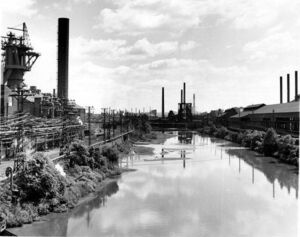
Steel Mill along Mahoning River 1962—Photo donated by Joseph E. Cole to the Cleveland Memory Project
The Mahoning Valley, like everywhere else, has been significantly impacted by these shifts and shuffles, on screens and off. So much so, the region is rethinking
its identity, moving from the Steel Valley to the Mahoning River Valley to Voltage Valley. The landscape is in many ways literally shifting and so too are residents’ opinions of and relationships to this place.
Some of these changes were for the not so good, while some things were definitely for the greater good.
The region continues to be at top of the wrong lists:
- The Food Research and Action Center’s “How Hungry Is America?” report
- The Business Journal reporting “Youngstown Tied for Ohio’s Top Unemployment Rate”
- The much circulated MoneyWise article showing Younstown as the poorest city in the country
But, the region also stands near the top of better ones:

Warren Mayor Doug Franklin and Youngstown Mayor Tito Brown Paddling on the Mahoning River, Discussing River Restoration—Photo by Jamael Tito Brown, 2018
- Forbes Magazine revealed the region as the 4th best location to raise a family
- College Consensus placed Youngstown State University at 7 on a list of the 100 most affordable colleges or universities in the country
- Smart Asset has ranked the region at the top of its list for housing affordability and healthcare access for multiple years
And, HCP has hope for continued upward momentum:
- The Robert Wood Johnson Foundation’s County Health Rankings report Mahoning and Trumbull Counties sitting in the 60s (68 and 64 respectively) out of Ohio’s 88 counties, but Mahoning has shown significant progress—climbing to 68 from 75.
Dozens of organizations, initiatives, and individuals have worked tirelessly to change the local and national narrative about the Mahoning Valley and figure out what needs to be done to improve outcomes and opportunities. Shifting stories and statistics is hard work, some might consider it close to the realm of miracle work. But, it is possible as long as the doing is done with trust, transparency, and transformation as shared core values.
At only 3 years old, the Healthy Community Partnership is still a new kid on the block in the area of convening and catalyzing community change. However, many of our partners have been rolling up their sleeves and digging in—sometimes quite literally—for many, many years.
Two of HCP’s Parks and Greenspaces partner organizations—the Mahoning County Land Bank and the Trumbull County Land Bank—are celebrating the big 1-0. To share in the celebration of their individual and collective accomplishments over the last ten years, we’d like to raise up their accomplishments—beyond razing vacant, blighted houses. The efforts of both county land banks have enabled resident leaders, business leaders, and elected leaders to realize possibility where things have seemed impossible, to feel hope when things seemed hopeless, and to plant seeds that will one day blossom into bright, beautiful blooms—literally and metaphorically.
Mahoning and Trumbull Counties both have Land Reutilization Corporations, more commonly known as the Mahoning County Land Bank and Trumbull County Land Bank, that have successfully used millions of dollars (each county received over $15 million during the lifespan of the program from 2014-2020) from the U.S. Department of the Treasury through the Hardest Hit Fund program that were reappropriated and distributed as the Neighborhood Initiative Program (NIP). These funds administered through the Ohio Housing Finance Agency allowed county land banks “to stabilize property values by removing and greening vacant and blighted properties in targeted areas in an effort to prevent future foreclosures for existing homeowners.”
A component of NIP included funds for post-demolition “greening.” Eliminating vacant, blighted properties creates empty, open spaces in neighborhoods, blank canvases waiting for painting with plants or other materials to make real creative visions.
Though operating in two separate counties, the missions of these organizations share common goals to strengthen communities, repurpose vacant land to productive uses, and positively impact property values. All of these focus areas have direct connections to and impacts on health. Whether they are demolishing a deteriorating house or collaborating with neighbors to plan, plant, and put in place a pocket park, the land banks have cleared the way for transformation and create opportunity for residents to live healthier, more fulfilling lives.
In their own words, here are Mahoning County Land Bank Executive Director, Debora Flora, and Trumbull County Land Bank Program Associate, Jessica King, to share their reflections about the Land Banks accomplishments over the past decade and offer insights and inspiration about future projects, plans, and impacts on neighborhoods, health, and prosperity.
Debora Flora, Executive Director, Mahoning County Land Bank
Jessica King, Land Bank Associate, Trumbull County Land Bank
Mahoning & Trumbull County Land Banks Demolitions & Greenspaces Gallery
- Mahoning County Land Bank: Demolition
- Mahoning County Land Bank: Little Free Library
- Mahoning County Land Bank: WRTA Bus Shelter
- Mahoning County Land Bank: Neighborhood Greenspace
- Mahoning County Land Bank: Neighborhood Greenspace
- Mahoning County Land Bank: Neighborhood Greenspace
- Mahoning County Land Bank: Neighborhood Greenspace
- Mahoning County Land Bank: Neighborhood Greenspace
- Mahoning County Land Bank: Little Free Library
- Trumbull County Land Bank: Demolition
- Trumbull County Land Bank/TNP: Neighborhood Greenspace
- Trumbull County Land Bank/TNP: Neighborhood Greenspace
- Trumbull County Land Bank/TNP: WRTA Bus Shelter Art Project
- Trumbull County Land Bank/TNP: Neighborhood Greenspace
- Trumbull County Land Bank/TNP: Little Free Library
- Trumbull County Land Bank/TNP: Neighborhood Greenspace
- Trumbull County Land Bank/TNP: Neighborhood Greenspace
- Trumbull County Land Bank/TNP: Neighborhood Greenspace





